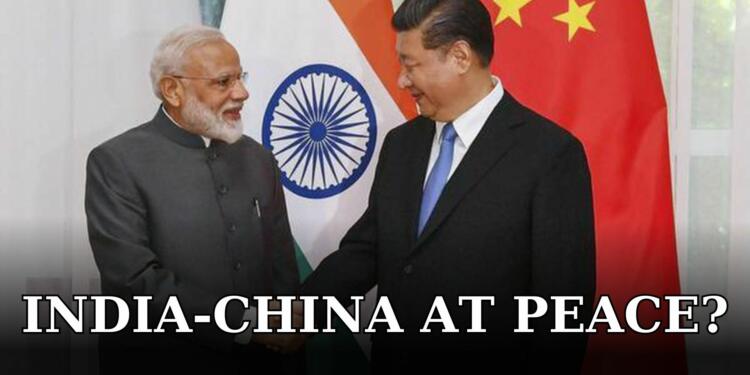India’s unwavering stance against China’s hegemonic actions underscores its steadfast commitment to preserving territorial integrity and sovereignty. Recent developments in India-China relations reflect India’s resolute response to Chinese objections and provocations, particularly regarding territorial disputes in regions like Arunachal Pradesh and Ladakh. This article delves into India’s strategic framework in countering China’s assertive behavior, encompassing territorial assertions, military preparedness, economic resilience, and diplomatic alliances. It emphasizes India’s multi-faceted approach to safeguarding national interests and promoting regional stability amid escalating tensions with China.
Upholding Territorial Integrity
India’s stance on territorial disputes, particularly in regions like Arunachal Pradesh, Ladakh, and other border areas, reflects its unwavering commitment to safeguarding its sovereignty and territorial integrity. Despite ongoing tensions with China, India has consistently rejected Chinese claims to these territories and asserted its rightful sovereignty over them.
In Arunachal Pradesh, India has categorically stated that the region “was, is, and will always be an integral and inalienable part of India.” This assertion comes in response to Chinese objections and protests, which have been a recurring theme whenever high-level visits to Arunachal Pradesh occur. India’s rejection of Chinese claims underscores its firm stance on the matter, refusing to entertain any compromise on its territorial sovereignty.
Similarly, in Ladakh and other border areas, India has remained steadfast in defending its territory against Chinese aggression. The standoff along the Line of Actual Control (LAC) since April 2020 has highlighted India’s resolve to protect its borders and uphold its territorial integrity. Despite the tense and dangerous situation, India has reiterated its commitment to finding a fair and reasonable resolution to the standoff while insisting on respecting bilateral agreements and maintaining the status quo.
India’s diplomatic responses to Chinese protests and objections have been marked by a combination of firmness and pragmatism. External Affairs Minister S Jaishankar’s remarks at the Express Adda underscored India’s willingness to engage in dialogue while firmly upholding its principles and interests. By emphasizing the importance of observing agreements and respecting the LAC, India has sought to convey the message that any resolution to the border dispute must be based on mutual respect and adherence to established norms.
Also Read: India-China Border Dispute and the Path to Resolution: Pursuing Peace?
Strategic Military Measures
In response to China’s aggressive posturing along the LAC, India has adopted a series of military strategies and measures aimed at bolstering its defense capabilities and deterring potential aggression. These strategies are guided by the imperative of defending India’s borders while upholding the principles of peace and stability in the region.
India’s military posture along the LAC emphasizes both deterrence and defense. While remaining committed to observing bilateral agreements and protocols, India has maintained a high state of readiness to respond effectively to any provocation or incursion by Chinese forces. This readiness is underscored by ongoing military exercises, deployments, and infrastructure developments in border areas aimed at enhancing surveillance, mobility, and operational preparedness.
Recent military developments, including the sanctioning of funds for frontier highway construction in Arunachal Pradesh and the successful testing of the Agni-5 MIRV missile, demonstrate India’s resolve to bolster its defense infrastructure and capabilities. These developments are integral to India’s efforts to enhance deterrence and counter any potential threats along its borders.
India’s emphasis on military preparedness and deterrence is complemented by a commitment to diplomatic engagement and conflict resolution. By combining military strength with diplomatic engagement, India seeks to maintain peace and stability along the border while safeguarding its territorial integrity and national security interests.
Also Read: China’s Broken Promises & Jaishankar’s Strong Remarks for Indo-Pacific Stability
Technological Resilience
India has been actively pursuing measures to reduce its dependency on Chinese products and technology, particularly in critical sectors such as telecommunications and manufacturing. Recognizing the strategic importance of achieving self-reliance, India has implemented various initiatives to promote indigenous manufacturing, attract foreign investment, and foster partnerships with like-minded countries.
In the telecommunications sector, India has taken steps to encourage domestic production of telecom equipment and components through initiatives such as the Production Linked Incentive (PLI) scheme. This scheme offers financial incentives to companies that manufacture telecom equipment domestically, thereby reducing reliance on Chinese imports. Additionally, India has tightened regulations and scrutiny on Chinese companies operating in the telecom sector to ensure compliance with Indian laws and regulations.
In manufacturing, initiatives such as “Make in India” aim to promote domestic production across various sectors, thereby reducing dependence on imports, including from China. The Indian government has also been actively seeking foreign investment, particularly from countries like Japan, South Korea, and the United States, to bolster domestic manufacturing capabilities and technology transfer.
Furthermore, India has forged strategic partnerships with countries like Taiwan, which is renowned for its advanced technology and manufacturing prowess. Collaborations in areas such as semiconductor manufacturing and electronics assembly are aimed at enhancing India’s technological resilience and reducing reliance on Chinese technology.
Also Read: Agni-V: India’s Firestarter or China’s Sleepless Nights?
Impact on the Indian Economy
The impact of India’s economic measures on Chinese companies operating in India has been significant. Stringent regulations and increased scrutiny have led to challenges for Chinese firms, particularly in sectors such as e-commerce, mobile manufacturing, and fintech. Indian directives requiring Chinese companies to comply with Indian laws and regulations, including taxation and data protection, have resulted in increased compliance costs and operational challenges for these firms.
From a geopolitical perspective, India’s efforts to reduce dependency on Chinese products and technology have broader implications for regional power dynamics. By diversifying its economic partnerships and reducing reliance on China, India seeks to assert its strategic autonomy and counter Chinese influence in the region. Strengthening domestic manufacturing capabilities and fostering partnerships with like-minded countries contribute to India’s efforts to promote stability and security in the Indo-Pacific region.
Diplomatic Outreach and Alliances
India has actively engaged in diplomatic efforts to counter Chinese influence and expansionism, both regionally and globally. Through strategic partnerships and alliances, India aims to bolster regional security and stability while challenging China’s assertive behavior.
One of the key pillars of India’s diplomatic strategy is strengthening partnerships with regional and global powers such as the United States, Japan, Australia, and Southeast Asian nations. These partnerships are grounded in shared interests and values, including a commitment to upholding a rules-based international order and promoting peace and prosperity in the region. Platforms such as the Quad, comprising India, the United States, Japan, and Australia, serve as forums for cooperation on issues of mutual concern, including maritime security, counterterrorism, and infrastructure development.
India’s proactive role in strengthening partnerships with like-minded countries has been particularly evident in its engagements with Taiwan. Despite pressure from China, India has maintained robust economic and people-to-people ties with Taiwan, recognizing its importance as a democratic partner and technology hub. India’s engagements with Taiwan challenge China’s one-China policy and assert India’s strategic autonomy in foreign policy decision-making.
In confronting China’s hegemonic behavior, India employs a comprehensive strategy spanning territorial, military, economic, and diplomatic fronts. Firmly asserting sovereignty over disputed territories, bolstering defense capabilities, reducing dependency on Chinese products, and forging alliances highlight India’s proactive approach. With unwavering resolve, India safeguards national interests while advocating regional stability and cooperation. However, in navigating complex geopolitical dynamics, continued vigilance, resilience, and strategic engagement remain imperative for India to effectively counter Chinese assertiveness and uphold peace in the Indo-Pacific region.
Also Read: From Dollars to Rupees: India’s Game-Changing Currency Conundrum






























